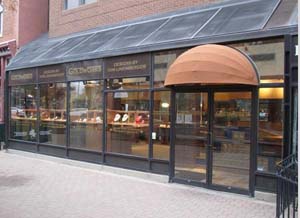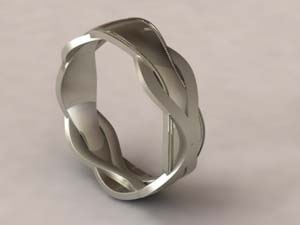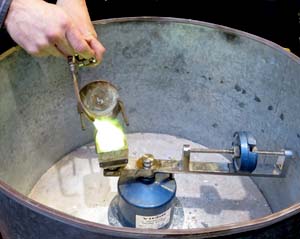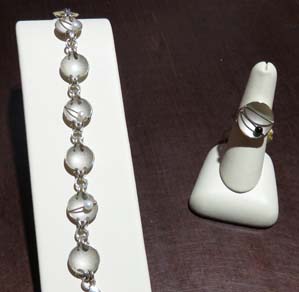
Goldworks, owned by jewelry designer Tom Linenberger and his wife Sandy, sits along the north side of Old Town Square in Fort Collins. (Photo provided by Goldworks)
Along the north side of Old Town Square in Fort Collins sits Goldworks, owned by Tom and Sandy Linenberger and filled with fine jewelry designed and created by Tom and fellow artisan Mark Videan.
Tom and Mark met in 1994 at a trade show in Denver. They had come from different Midwestern states to check out the CAD (computer-assisted-design) programs available for jewelry designers. Their enthusiasm for the same design program sparked a long-lasting friendship. Tom opened Goldworks in Fort Collins four years ago. A year later, he convinced Mark to join him.
Mixing Technology and Tradition

This ring design shown in white gold was created by Tom Linenberger at Goldworks in Fort Collins. (Photo provided by Goldworks)
Both Tom and Mark are still enthusiastic about using a CAD program to make sure they produce what their customers expect. Before CAD, they couldn’t always be certain that a customer completely understood their drawn design. With a CAD program, however, they can turn their design in every direction to show the customer every aspect of it.
Once the customer agrees to a design – a particular ring, for example — the CAD program guides the milling machine that creates a wax version of the ring. Before they used CAD, Tom and Mark sculpted the ring out of wax by hand. Now the computer gives them a perfect wax form and frees their time for other creative work.

Tom Linenberger uses a torch to heat the crucible in which he will melt sterling silver. The crucible is part of a centrifuge that will send the molten metal into a plaster mold of his jewelry design.
Work proceeds much the same way as it would if they were creating a large metal sculpture. The wax version of the ring is embedded in plaster, and the wax is burned off in a kiln. Now the plaster has become the mold that will shape molten metal. Tom and Mark can’t simply pour hot metal into the plaster mold, however; the metal would cool too much and solidify before it filled the mold. Instead, they use a centrifuge to send the molten metal from a crucible, hotter than a stove on high, into the plaster mold.
Timing the metal’s cooling is critical. If they try to remove the ring too soon, the metal will be soft. If they leave it in the mold too long, the metal will be brittle. At the right moment, they plunge the mold into water to accelerate cooling. At last they pull from the mold a plaster-coated ring with a metal stub at its shank where the metal had entered the mold.
The ring is still far from ready. After all plaster is removed and the stub is sawed off, the ring must be tumbled, sanded, polished, set with stones if there are any, and engraved. In spite of all today’s technology, Tom and Mark still need many of the tools that jewelers have been using for centuries.
Rolling in Stones

These white gold earrings designed by Tom Linenberger were a recent work in progress at Goldworks. Mark Videan was setting 82 diamonds in five sizes into the white gold. (Photo by Mark Videan)
Recently Mark was working on setting diamonds into 14-karat white gold earrings. Into tiny holes dotting gold swirls he was setting diamonds smaller than bread crumbs on my kitchen counter. Powerful lenses mounted on his worktable helped him place them accurately. By the time he finishes the earrings, he will have placed 82 tiny diamonds by hand.
Dumbfounded by diamonds measured in tenths of a millimeter, I asked Mark if they couldn’t scatter easily from the simple plastic bag that held them. “That’s why we always keep a tray under our work,” Mark told me. He added that after moving Goldworks into its space on Old Town Square, Tom rolled up the carpet where the previous jeweler had worked for nearly 20 years and sent it to the metal supplier that recycles scraps and refuse of precious metals. The supplier credited Tom with $4,000 for the gold dust that it had recovered from the carpet.
Tiny gems aren’t the only thing that could scatter easily. Tom receives metal from the supplier in the form of beads smaller than peas. Beads are the natural result of pouring molten metal into water. They make it easy for jewelers to measure the amount they will need to melt for a particular piece of jewelry.

A safe made in 1871 and transported to Fort Collins from St. Louis holds precious metals and gems at Goldworks.
Tom keeps yellow gold, white gold, rose gold, and sterling silver on hand. All of these metals come as alloys because in their pure form they would be too soft. For years nickel has given white gold its silvery tone; however, because many people are allergic to nickel, Tom buys white gold that gets its color from palladium instead. Rose gold takes on a slightly orange tone from copper.
The safe where all this precious metal is kept is a centerpiece of the Goldworks showroom. Made in 1871, the vault itself is a work of art. Above the safe sit numerous trophies Tom has won for his jewelry designs and fabrication.
Making Wishes Come True

Mark Videan designed this bracelet and ring as part of his Cosmic Collection, on display at Goldworks in Fort Collins.
Glass cases in front of the safe display work by both Tom and Mark. Customers may be drawn to a particular design but may prefer a different metal, a different stone, or some other variation. Not a problem to these artisans – they’re happy to make a new version to meet customers’ tastes.
Tom and Mark also welcome requests for something that’s one of a kind. They may look at pictures with a customer to get an idea of what style the customer wants. They can then use their CAD program to make a new design and adjust details while the customer gives them feedback. Considering all the variations that are possible on any design and their pleasure in fulfilling customer requests, Tom and Mark rarely do make the same piece twice.
Sometimes people come in with heirloom jewelry, treasured because of memories but unworn because of style. Tom and Mark enjoy creating new designs that will use all the metal and gems. They gladly photograph the original jewelry, the fabrication process, and the new pieces and provide a bound picture book to share with generations to come.
When you’re wandering through Old Town Square in the evening or on a Sunday or Monday, don’t let the empty window display fool you. Goldworks is only closed for a little while. Visit during the day Tuesday through Saturday to check out the latest displays. I found some of my favorite designs scrolling through its Facebook page. For more information and an overview of its jewelry, check out www.OldTownGoldworks.com.